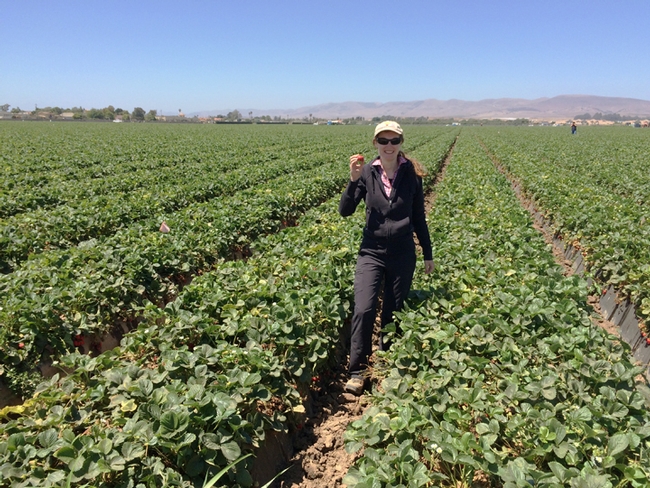- Author: Kathy Keatley Garvey
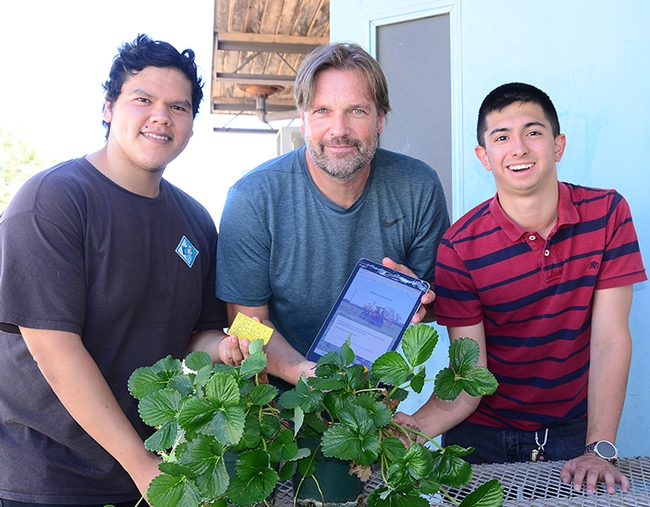
“Many variables are known to affect the actual spray coverage in crop fields,” said Nansen, an associate professor in the UC Davis Department of Entomology and Nematology said. “These include tractor speed, spray nozzles, spray volume, boom height, adjuvants, and weather conditions. But which ones are the most important ones? And are there possible interactions among some of these variables?”
Through Smart Spray, an app designed for both iOS and Android phones, growers can optimize and perform quality control of pesticide spray applications in their strawberry fields, Nansen said.
Computer science major Krishna Chennapragada, now an alumnus, launched the programming and initial design, tallying some 500 hours before his graduation. Today's team, in addition to Nansen, is comprised of recruits Gabriel Del Villar, a 2019 computer science graduate, and Alexander Recalde, a senior majoring in computer science. Together they have amassed nearly 400 hours on the project.
“The project is truly multidisciplinary,” said Nansen, adding “One of the great things about UC Davis is that the barriers between colleges are very, very shallow.”

The Smart Spray app, they said, allows a user to predict spray coverage under different operational scenarios, including type of nozzles, spray volume, and tractor speed, as well as weather data, such as temperature, relative humidity and wind. A key part of the process: the user places a water-sensitive card in the field prior to a spray application, photographs it, and uploads it into the app.
“If you're a grower, you might expect that when you go out to spray, that the more that comes out of nozzle, the better coverage you'll get,” Nansen said. “But, for example, if the wind is too strong, the relative humanity is too low, the pressure is too high, or you're going too fast--even when you're spraying large volumes--you can get very poor coverage and it's costly. Excessive spray can also reach other fields or nearby urban developments due to so-called “spray drift”.”
“Typically, a grower will spray 100 to 150 gallons per acre when he or she sprays,” Nansen explained. The water-sensitive card is yellow, but it codes blue when it interacts with moisture. “These cards have been around a long time,” he said. “They cost about $1 a card, not cheap. But it's inexpensive when you're spending thousands of dollars to control the pests. And the pesticide companies can pay for the cards.”
“Say you want to predict your coverage before you spray tonight or tomorrow,” Nansen explained. “Look at the weather conditions; what is the forecast? Then how are you going to do this? What if you spray 100 gallons and want to go two miles per hour. You enter the data—and all the other applicable data--on the Smart Spray app. It will predict the coverage you'll get with nine different nozzles. Those are the nozzles the typical strawberry grower uses, a number we based on almost 3000 experimental sprays over three years. So we did a lot of homework on this, for example—different spray rigs, different sizes of crops, different spacing of plants, and under different weather conditions. We covered all the ranges we could think of. We collected the water and operational data and we did the progression analysis (for the modeling).”
“Using this prediction, you can give it a name, say Field 6, and access it from the database,” Nansen said. “It's about quality control. It's a tool to predict and do quality control. It empowers the grower and also the sprayer to do a better job. For example, if the conditions are bad and the app shows the spraying will be only 20 percent effective, you shouldn't be spraying.”
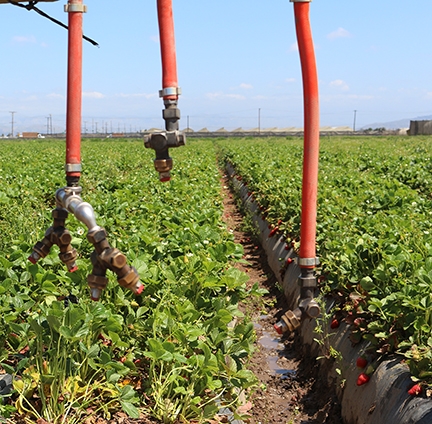
“The Smart Spray is not just insecticides--it's fungicides, herbicides, and whatever you want to spray,” Nansen noted. “This app was developed for strawberries; if it were used for soybeans, onions and cabbage, it would still be useful but the accuracy would be off.” Pending apps: almond, pistachio and tomato.
The computer scientists enjoy working on the project. Recalde attended a Central Coast sprayers' meeting to talk about the app. “I heard ‘Oh, wow, you look so young!' he remembered. “Then we told them about this useful tool, different ways that technology can be applied to agriculture. They were really interested in how technology can improve what they're doing.”
Del Villar, whose computer interests also include teaching youth how to code, said he eagerly looks forward to making the Smart Spray app even better and more useful. Fluent in Spanish, as well as English, he plans to translate the app into Spanish. Other language translations are also in the works.
Now the team is seeking feedback to improve the app. “We're hoping growers will embrace it,” Nansen said, “and help us find ways to improve it.”
One feedback from Eric Flora, global field development and manager of Crop Enhancement, Inc., Paso Robles: “I think Smart Spray is a very helpful tool for growers and advisers as a guide to select spray tips, spray volumes, tractor speed, and other important factors to maximize sprayer coverage. Using spray cards is the best and simplest way to know, if you are penetrating everywhere in the canopy your pest target is a problem--placing cards where the specific pests attack the host gives the best information.”
State, federal and industry grants, including the California Strawberry Commission and the Floriculture and Nursery Research Initiative (FNRI) of the U.S. Department of Agriculture's Agricultural Research Service, help fund the project.
California grows about 88 percent of the nation's strawberries on approximately 34,000 acres along the California coast, according to the Strawberry Commission. Strawberries are available year-around in California.
Statewide, fresh strawberry production averages 50,000 pounds per acre each season. The approximately 300 strawberry growers hail from five distinct areas of California: Watsonville/Salinas, Santa Maria, Oxnard, Orange County/San Diego, and the Central Valley. They include multi-generation farming families growing both organic and conventional strawberries.
For more information on the Smart Spray app, access the manual at https://bit.ly/2q3lsL3 or contact Nansen at chrnansen@ucdavis.edu or 530-752-2728.

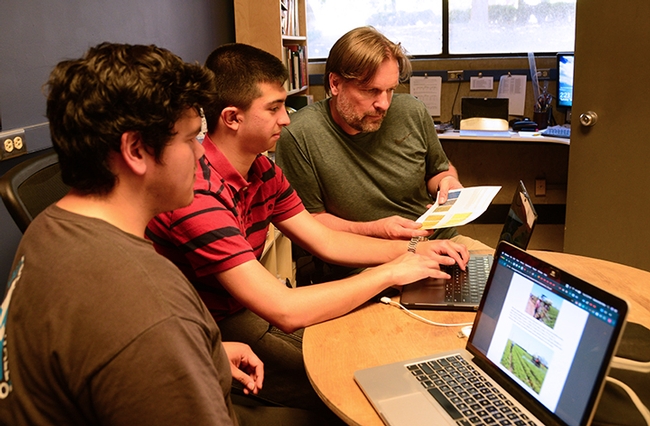
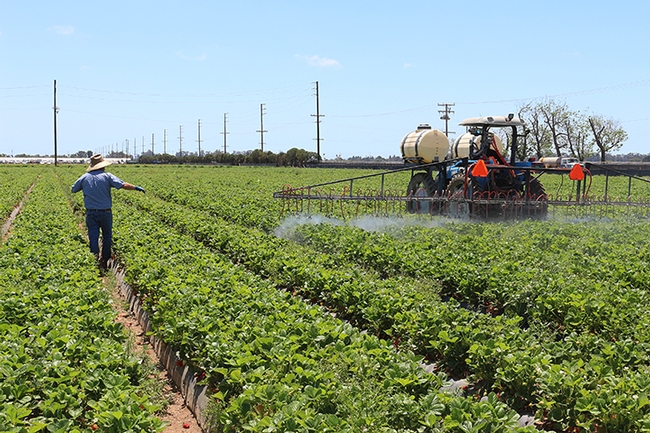
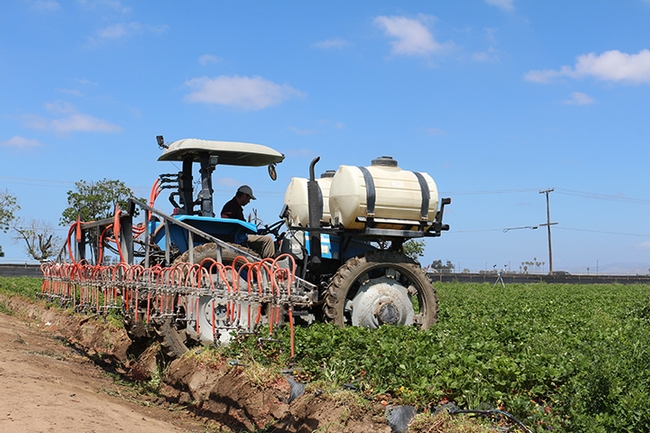
- Author: Kathy Keatley Garvey
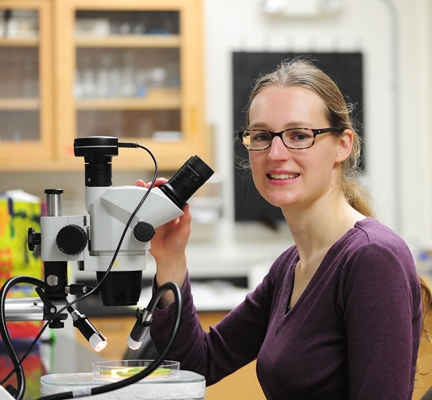
Chemical ecologist Elvira Simone de Lange, a postdoctoral researcher in the Christian Nansen lab, UC Davis Department of Entomology and Nematology, has received a three-year $249,878 federal grant that involves using drones to detect the early infestation of spider mites, and then targeting the pests with biocontrol agents.
The grant is from the U.S. Department of Agriculture's Western Sustainable Agriculture Research and Education (SARE) Program.
Her research project, "Unmanned Aerial System (UAS)-Guided Releases of Predatory Mites for Management of Spider Mites in Strawberry," aims to identify “very subtle differences in reflectance of the strawberry canopy, indicating spider mite-induced stress,” she said. “Releasing predatory mites in these spider mite hotspots will increase their efficacy as biocontrol agents, enhancing sustainability of spider mite management practices in strawberry.”
In her successfully funded proposal, she noted that “Farmers are requesting in-depth testing of how UAS can be integrated successfully into strawberry production to improve management practices.” UAS, or drones, can monitor large areas in a short period of time. California produces 88 percent of the nation's strawberries, with an annual value of approximately $2.6 billion.
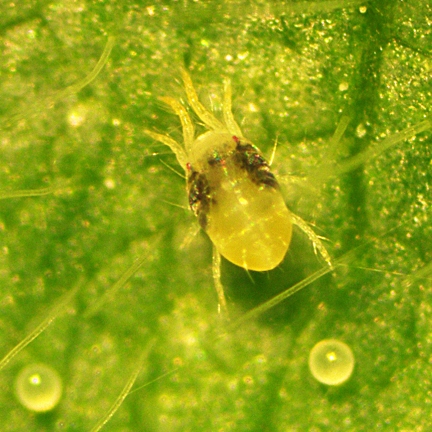
The three-year project, now underway through March 2020, also explores the use of drones as a novel, effective way of distributing the predatory mites.
The grant also calls for educational outreach programs, with hands-on workshops and lectures on spider mite sampling at grower and agriculture professional meetings throughout the California strawberry growing region. Growers outside this area will be reached through publications in trade journals and other grower media.
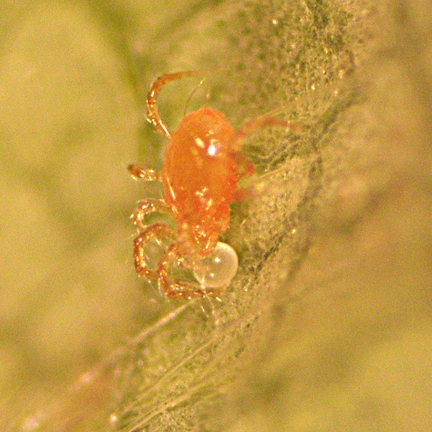
Multiple species of spider mites infest the state's strawberry fields. The twospotted spider mite, Tetranychus urticae, an annual pest of strawberries in all growing regions, is the predominant species in strawberries grown on the Central Coast, according to the UC Statewide Integrated Pest Management Program's Pest Management Guidelines (PMG), written by lead author and IPM specialist Frank Zalom, distinguished professor of entomology, UC Davis Department of Entomology and Nematology.
The mites suck plant juices. The damage can result in decreased fruit size and yield. Mite-feeding symptoms include dense webbing, and dry, brittle and discolored leaves.
“Twospotted spider mite feeding is particularly damaging during the first two to five months following transplanting in late summer or fall,” according to the PMG.
A native of The Netherlands, de Lange joined the Nansen lab in March 2016. She received her bachelor's degree in biology, and her master's degree in plant biology from Utrecht University, The Netherlands. She earned her doctorate in chemical ecology from the University of Neuchâtel, Switzerland. Her first postdoctoral position was at Rutgers University, New Jersey, where she worked on insect resistance in cranberries.
Overall, she hopes her research meshing chemical ecology, entomology, plant-arthropod interactions and biological control in the fields of integrated pest management and precision agriculture solutions, will “lead to the development of novel, sustainable pest management practices.”
